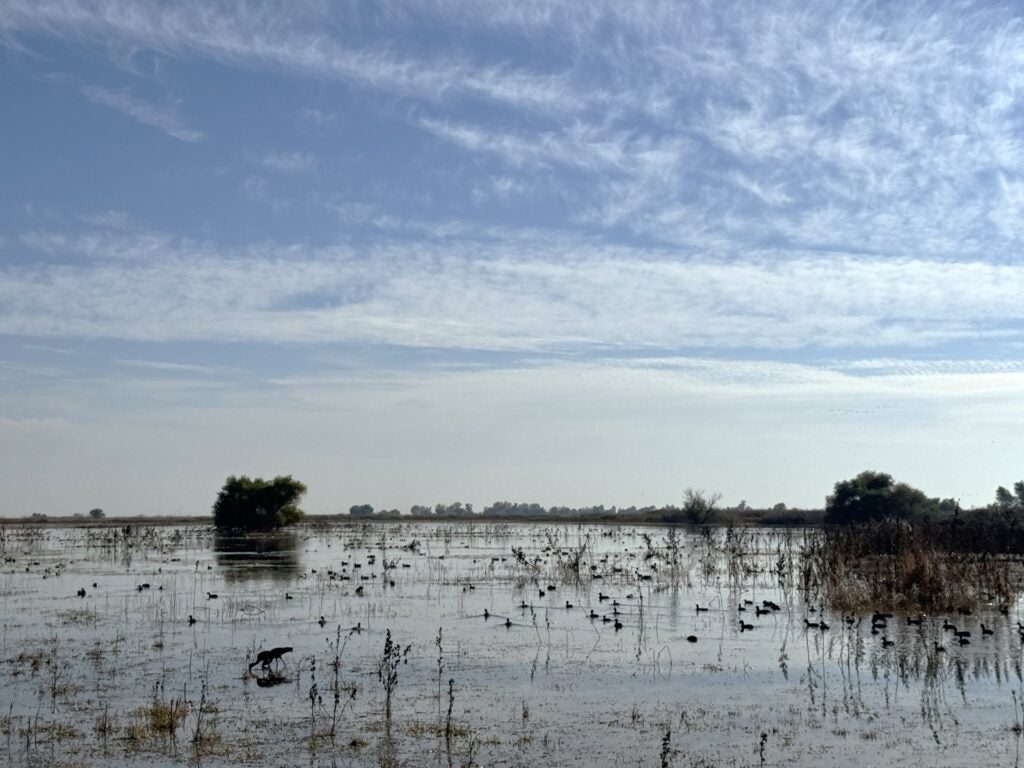

Photo: Merced Wildlife Refuge
Embarking on a field trip can often feel like stepping into a storybook, especially when the narrative and scenery revolve around transforming landscapes. This feeling was palpable last November when the Environmental Defense Fund organized a trip to Merced and Stanislaus Counties in California. The journey wasn’t just a tour; it was a vivid illustration of how multi-benefit land repurposing (MLRP) is bolstering groundwater sustainability in areas hardest hit by climate change. MLRP involves transforming areas where agriculture is least viable into thriving multibenefit land use mosaics that serve a multitude of purposes, from recharging groundwater to creating wildlife habitats, while providing payments to growers for voluntarily participating.
Two groundwater subbasins (Merced and East Turlock Subbasins) located in these counties were recently granted funding from MLRP. The program brings together a diverse array of partners and collaborators, including Groundwater Sustainability Agencies (GSAs), forming regional block grant teams, which will be developing projects that aim to support groundwater sustainability actions, enhance habitat connectivity, and benefit local communities.
Our field trip group included staff members from state legislative offices, local farmers, representatives from the United States Fish & Wildlife Service, the CA Department of Conservation, Merced and Turlock GSAs, and nonprofit organizations like River Partners and Self Help Enterprises.
During this field trip, attendees had the opportunity to talk with MLRP grant recipients, growers, and habitat restoration practitioners that are implementing multi-benefit projects in the region. Seeing firsthand how MLRP is being utilized is key for increasing support for the program and envisioning a sustainable future for San Joaquin Valley.
Our first destination was the Merced National Wildlife Refuge, a vital habitat for thousands of migratory birds. Here, the Department of Conservation and staff from US Fish & Wildlife highlighted the refuge’s significance for these birds. The conversation also addressed challenges in water management during droughts, focusing on the Sustainable Groundwater Management Act and its implications for the area. Reyn Akiona from Great Valley Seed and Valley Ecco discussed the vision for a wildlife corridor extending from the refuge to the Sierra Nevada, capturing everyone’s imagination.
At Joseph Gallo Farms in Atwater, over lunch, we delved deeper into MLRP. Mike Gallo, CEO of the farm, alongside Anna Schiller from EDF, and other notable figures like Brad Samuelson of Water and Land Solutions, John Cain of River Partners, Keali’i Bright of DOC, and Eddie Ocampo of Self-Help Enterprises, shared their perspectives. This gathering was more than a meal; it was a confluence of ideas, emphasizing the importance of multi-stakeholder collaboration and shared visions for sustainable land use. The key role of MLRP in fostering these collaborations, particularly the engagement of farmers and communities, was a focal point of discussion.
After lunch, our visit to a project site with River Partners showcased the transformation of agricultural land into a restored floodplain that will both support habitat while contributing to groundwater recharge. This visit was not only informative but also visually impactful, as we observed migratory birds like the blue-gray heron finding refuge in these newly created habitats, exemplifying the direct impact of these projects on wildlife.
The final stop of our journey was the Burroughs Family Farm in Denair. Rosie and Ward Burrough shared their experience with implementing regenerative agricultural practices. They discussed a fascinating project seeking MLRP funding to restore […]
Full article: blogs.edf.org
Clean water is essential for life, yet millions of Americans unknowingly consume contaminants through their…
Human brains contain higher concentrations of microplastics than other organs, according to a new study, and the…
From the Office of the Governor: In anticipation of a multi-day, significant atmospheric river in Northern California,…
From Governor Newsom: Scientists, water managers, state leaders, and experts throughout the state are calling…
Photo: A harmful algal bloom in Milford Lake, Kansas, made the water appear bright green.…
An expanded plastic foam coffee cup is at a donut shop in Monterey Park, California.…